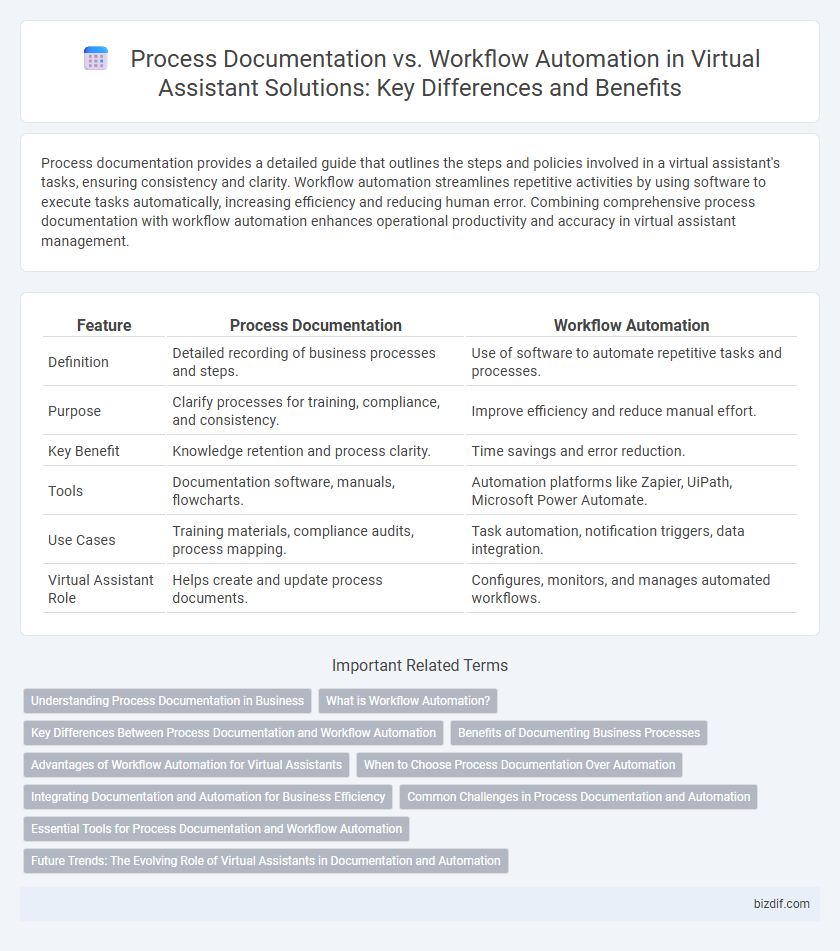Process documentation provides a detailed guide that outlines the steps and policies involved in a virtual assistant's tasks, ensuring consistency and clarity. Workflow automation streamlines repetitive activities by using software to execute tasks automatically, increasing efficiency and reducing human error. Combining comprehensive process documentation with workflow automation enhances operational productivity and accuracy in virtual assistant management.
Table of Comparison
| Feature | Process Documentation | Workflow Automation |
|---|---|---|
| Definition | Detailed recording of business processes and steps. | Use of software to automate repetitive tasks and processes. |
| Purpose | Clarify processes for training, compliance, and consistency. | Improve efficiency and reduce manual effort. |
| Key Benefit | Knowledge retention and process clarity. | Time savings and error reduction. |
| Tools | Documentation software, manuals, flowcharts. | Automation platforms like Zapier, UiPath, Microsoft Power Automate. |
| Use Cases | Training materials, compliance audits, process mapping. | Task automation, notification triggers, data integration. |
| Virtual Assistant Role | Helps create and update process documents. | Configures, monitors, and manages automated workflows. |
Understanding Process Documentation in Business
Process documentation in business involves detailed recording of all steps, roles, and responsibilities within a task or operation to ensure clarity and consistency. It serves as a reference that supports training, compliance, and performance analysis while enabling seamless knowledge transfer. Accurate process documentation forms the foundation for effective workflow automation by providing clear guidelines for configuring automated systems.
What is Workflow Automation?
Workflow automation is the use of technology to execute recurring tasks or processes in a business where manual effort can be replaced. It involves creating a sequence of automated actions that streamline operations, reduce errors, and improve efficiency. Unlike process documentation, which provides a detailed outline of steps, workflow automation actively performs those steps using software tools such as robotic process automation (RPA) or business process management (BPM) systems.
Key Differences Between Process Documentation and Workflow Automation
Process documentation captures detailed descriptions and step-by-step instructions of tasks to ensure clarity and consistency, serving as a reference for team members and training. Workflow automation uses software tools to execute repetitive tasks automatically, improving efficiency by reducing manual intervention and minimizing errors. Key differences include process documentation focusing on information preservation and knowledge sharing, while workflow automation emphasizes operational execution and task streamlining.
Benefits of Documenting Business Processes
Documenting business processes provides a clear and structured reference that enhances training efficiency and ensures consistency across teams. It identifies bottlenecks and areas for improvement, enabling targeted workflow automation that boosts productivity. Well-documented processes support compliance and risk management by maintaining accurate operational records.
Advantages of Workflow Automation for Virtual Assistants
Workflow automation enhances efficiency for virtual assistants by streamlining repetitive tasks and reducing manual errors, leading to faster completion times. It enables seamless integration of multiple applications, improving task coordination and minimizing the risk of oversight. Automation also allows virtual assistants to scale their services effortlessly, handling increased workloads without compromising quality.
When to Choose Process Documentation Over Automation
Process documentation is ideal when the primary goal is to capture detailed, step-by-step instructions for complex or variable tasks that require human judgment. It supports training, compliance, and knowledge retention without the need for immediate technological implementation. Choosing documentation over automation is essential when processes frequently change or lack standardization, making rigid automation less effective.
Integrating Documentation and Automation for Business Efficiency
Integrating process documentation with workflow automation enhances business efficiency by ensuring accurate, real-time execution of tasks based on well-defined procedures. Automated workflows driven by comprehensive documentation reduce errors, streamline operations, and facilitate consistent performance tracking across departments. Leveraging tools like UiPath and Microsoft Power Automate enables seamless synchronization between documented processes and automated systems, boosting productivity and operational transparency.
Common Challenges in Process Documentation and Automation
Process documentation often faces challenges such as incomplete, inconsistent, or outdated information, which hinders accurate representation of workflows. Workflow automation struggles with handling unstructured data and requires seamless integration across multiple systems to function effectively. Both areas demand continuous updates and collaboration to ensure alignment between documented processes and automated tasks.
Essential Tools for Process Documentation and Workflow Automation
Process documentation relies on essential tools such as flowchart software, process mapping applications, and collaboration platforms like Microsoft Visio, Lucidchart, and Confluence to visually capture and detail each step within business operations. Workflow automation utilizes tools like Zapier, Microsoft Power Automate, and UiPath to streamline repetitive tasks by integrating applications and automating rule-based processes, enhancing efficiency and reducing human error. Combining these tools enables organizations to clearly define operations and implement automation effectively, driving productivity and consistency in virtual assistant-driven workflows.
Future Trends: The Evolving Role of Virtual Assistants in Documentation and Automation
Virtual assistants are increasingly integrating AI-driven process documentation with workflow automation to enhance operational efficiency and accuracy in businesses. Future trends highlight the shift towards intelligent virtual agents capable of autonomously capturing detailed process data while simultaneously triggering automated workflows based on real-time contextual analysis. This evolution reduces manual oversight, accelerates decision-making, and fosters adaptive enterprise environments through continuous learning algorithms embedded within virtual assistant platforms.
Process documentation vs Workflow automation Infographic

 bizdif.com
bizdif.com